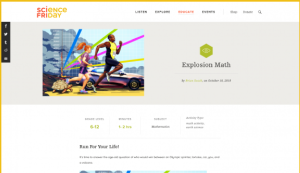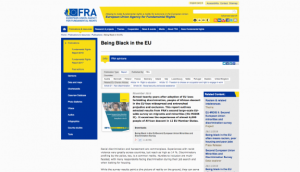Research and Education
Back to Top
|
 |
|
Ethics Unwrapped
|
Philosophy |
|
Educators in a wide variety of disciplines will find helpful teaching resources at Ethics Unwrapped, a program from the University of Texas at Austin's Center for Leadership and Ethics, part of the McCombs School of Business. Visitors to this project will find a rich, well-organized library of short educational videos created by the Ethics Unwrapped team that "emphasize the practical application of behavioral ethics to provide the next generation of leaders with the tools they need to act with integrity." A good place to start is the curated resources section, where visitors can choose among disciplinary groupings such as science, leadership, and behavioral ethics to find a collection of videos explaining relevant ethics concepts, each accompanied by discussion questions, case studies, teaching notes, and a bibliography of further resources. Readers may also enjoy exploring Ethics Unwrapped's other video series Scandals Illustrated, which currently offers 29 one-minute videos with teaching resources on recent events like the Equifax data breach. Ethics Unwrapped was created by program director Cara Biasucci. She is assisted by the program's producer Lazaro Hernandez, its coordinator Ian Ishak, and many others. [JDC] |
|





|
|
 |
|
NASA: Scientist for a Day
|
Science |
|
NASA's Cassini mission to Saturn may have ended in 2017, but its educational legacy lives on in numerous ways, including NASA's annual essay contest called Scientist for a Day. Both STEM and English teachers may be interested in assigning this essay contest to their students, which "challenges students in grades 5-12 to think like NASA scientists." For each year's contest, students research three specified locations in space, then based on their research decide which one would be the best for NASA to study further. For example, this year students are asked to learn about Saturn's moons Enceladus and Titan, as well as Jupiter's moon Europa and consider whether any of them could be habitable. As their contest entry, students write a 500-word essay explaining their choice. The winning essays - with one chosen for each topic in each grade group - will be posted on NASA's Solar System Exploration website (featured in the 6-18-2018 Scout Report), and US winners have the opportunity to participate in a video or teleconference with NASA scientists. Students outside the US may also be eligible to enter through their country's national coordinator. The deadline for the 2018-2019 contest is February 8, 2019. [JDC] |
|





|
|
 |
|
The 2018 report of the Lancet Countdown on health and climate change
|
Science |
|
The Lancet Countdown, an international research collaboration convened by the prestigious Lancet medical journals, is "an independent, global monitoring system dedicated to tracking the health dimensions of the impacts of, and the response to, climate change." The Lancet Countdown began publishing annual reports in 2016 and recently released their 2018 report, which draws on studies from multiple disciplines, such as climate scientists, social and political scientists, and public health professionals, and presents data for 2017 on 41 indicators across a range of themes. One of the key messages of their 2018 report is that the effects of climate change, including increased heat waves and vector-borne diseases, are already causing negative impacts on human health. The report also found that a "lack of progress in reducing emissions and building adaptive capacity ... [has] the potential to disrupt core public health infrastructure and overwhelm health services." Interested readers can access the full 36-page report with a free account. The Lancet Countdown's 2018 report was produced collaboratively between 27 universities, academic institutions, and intergovernmental agencies around the world, including the World Health Organization and the World Bank, with financial and technical support from the Wellcome Trust. [JDC] |
|





|
|
 |
|
Celebrating Simms
|
Social studies |
|
Celebrating Simms is an online companion to the permanent exhibition dedicated to the life and work of educator Lucy Simms and to the Lucy F. Simms School, which was named in her honor. Built shortly after Simm's death in 1934, the Lucy F. Simms School "served African-American students from all over Rockingham County [Virginia] and beyond between 1938 and 1965." This online exhibit emerged from a collaboration between Mollie Godfrey, a professor of English and Africana Studies at James Madison University (JMU); Sean McCarthy, also an English professor at JMU; and Robin Little, founder and president of the Shenandoah Valley Black Heritage Project. Together, Godfrey, McCarthy, and Little worked with a number of JMU students to research the history of the Lucy F. Simms School, as well as the broader history of African-American education in Harrisonburg, Virginia. At the center of this website is the Celebrating Simms exhibit, which includes a biography of Simms, a consideration of her legacy, and a number of related images and primary documents. In addition, visitors can explore an interactive timeline and map that documents the history of African-American Harrisonburg from the seventeenth century through the present. Celebrating Simms offers a valuable resource for history instructors, as well as anyone interested in the history of education and African-American history. [MMB] |
|





|
|
 |
|
Science Friday: Explosion Math
|
Mathematics |
|
Both math and earth science educators may be interested in Explosion Math, a lesson plan provided by Science Friday's Educator Collaborative (featured in the 10-13-2017 Scout Report). In this standards-aligned lesson, which was written for middle and high school students, learners are challenged "to answer the age-old question of who would win between an Olympic sprinter, tortoise, car, you, and a volcano." Here, students use the slope-intercept form to calculate how much of a head start each subject would need to escape from two different volcanoes, Kilauea in Hawai'i and Fuego in Guatemala, both of which erupted in 2018. Along the way, students learn about (or review) the differences between shield and stratovolcanoes and their respective types of flows and reflect on the real-world implications of this scenario. This lesson is designed to take one to two hours to complete and includes multiple illustrative images and GIFs, as well as downloadable handouts and slides. Explosion Math was written by Brian Soash, Science Friday's Educator Community Leader and a former middle school math and science teacher. [JDC] |
|





|
|
 |
|
The Bit List of Digitally Endangered Species
|
Science |
|
Have you ever wondered about the life expectancy of various forms of digital media? The Digital Preservation Coalition (DPC) curates a list of digitally endangered species, which is reviewed on an annual basis and is made public via this website. The Bit List Jury, which is comprised of an "esteemed international panel of digital preservation experts," assesses digital materials and formats of concern and includes their findings in varying categories listed here. The most recent revision was completed in November 2018. The Bit List full report is available via a PDF from the Endangered Species page, but readers wishing for summarized content should check out the listed categories on the site. Risk classifications are broken down into lower risk (currently containing no digital materials), vulnerable (web-based social media platform posts), endangered (born-digital photos and video uploaded to social media or cloud services), critically endangered (born-digital materials stored on external or portable storage devices), and practically extinct (pre-WWW data and bulletin board services). There is also a category for digital materials of concern that the Bit List Jury will review in the future. Each risk classification category includes examples of the concerned digital media and reasoning for being concerned. For more detailed information about each of these risk classifications, readers should peruse the detailed Bit List report mentioned previously. Readers wishing to delve further into digital preservation (particularly if concerned about their organization's current digital preservation plan) should check out the Executive Guide to Digital Preservation, which is available via a separate tab on the DPC site. [JLB] |
|





|
|
 |
|
 |
|



















